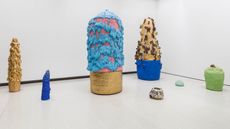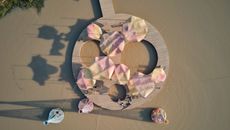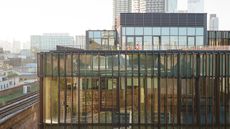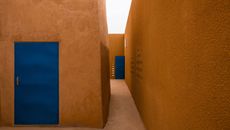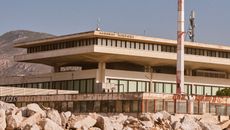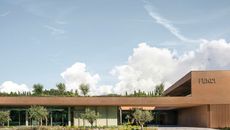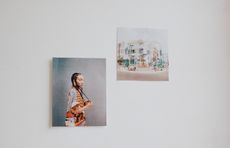Limbo Accra and Ibiye Camp talk African urban landscapes and digital archives
In our profile series with Ghanaian spatial design studio Limbo Accra, we meet its rich network of collaborators. Here, spatial artist Ibiye Camp completes our journey with a discussion on the urban landscape in Africa and digital archives
- (opens in new tab)
- (opens in new tab)
- (opens in new tab)
- Sign up to our newsletter Newsletter
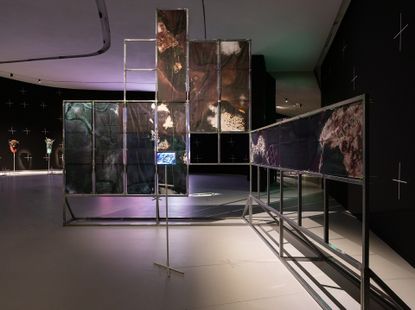
Over the past year, Ghanaian spatial design studio Limbo Accra, developed a series of conversations together with Wallpaper*, engaging with creative practitioners that inspire the studio, in Africa and its diaspora. From democratising architectural perspectives through photography with Jerald ‘Coop’ Cooper of Hood Century, to challenging design paradigms with Tawanda Chiweshe of Alaska Alaska, and empowering the next generation of African designers with Nifemi Marcus-Bello of nm bello Studio, we round off this series by exploring Limbo Accra’s nascent collaboration with artist Ibiye Camp.
Ibiye Camp and Limbo Accra
Ibiye Camp is a multidisciplinary artist and lecturer at the Royal College of Arts (RCA) in London. With a Nigerian mother and English father, Camp’s work reflects her upbringing, straddling the binaries of her identity. Moreover, growing up against the backdrop of London’s East Street Market, with ‘market stalls selling plantain, yam, Scotch bonnets, lace and Dutch wax prints’, Camp found herself ‘searching for Nigeria’, a journey manifested in her work through the omnipresence of textiles, market stalls and themes of labour in public spaces.

Ibiye Camp's Area Snap Devices (Data: The New Black Gold)
Camp reflects that she ‘was always curious about architecture’. She applied to do an MA in architecture at the RCA – drawn in by opportunities to explore intersections between the social and architectural across myriad mediums. With a keen interest in technology, Camp researched data centres, and how ‘imperialist structures influence internet access in Africa’.
She began using photogrammetry, scanning moments of data exchange in places such as Balogun Market in Lagos, in order to better document spaces in ways ‘representative of the actions that happen within them’.

Area Snap Devices (Data: The New Black Gold) film still
Limbo Accra founder Dominique Petit-Frère’s practice of activating unfinished building sites through creative expression and Camp’s methods of documenting activities of spaces through technology, led to their natural confluence in Accra, in late 2021. This meeting developed into a partnership, and the two together are now planning to create a digital archive by scanning various sites in limbo across West Africa, starting in Accra and Freetown.
These limbo structures are a recognisable aesthetic across West Africa, with deep cultural significance. Petit-Frère explains that ‘they reflect the different levels of exploitation within the construction industry and its disabling effect on the urban landscape.’ Petit-Frère guided Camp to Labadi Beach Tower in Accra, a 17-storey building, one of two of its kind planned to be built, to take scans. Camp says: ‘There were caretakers who warned, “You can’t get close, it’s not safe”, so I ended up circling the building’, which she describes as a ‘ghostly presence’.

Labadi Beach Tower
In smaller structures, a chair, a washing line, or a piece of fabric across an imaginary doorway mark signs of inhabitants. Petit-Frère says: ‘Children are born within these arrangements, feeling and knowing that it’s home, but under these liminal jurisdictions never knowing when it’s time to go.’
The pair’s digital archive questions the future of the urban landscape in Africa, while keeping pace with the world's reconfiguration into digital spaces. It will explore how urbanists, designers, and artists alike, can create new spatial artefacts that, for Petit-Frère, ‘simultaneously honour their visions while orienting them towards the future’. With plans for first-person-controller and augmented-reality functions, users will be able to highlight views, borders and details of each individual site, which will eventually form part of wider 3D digital cities that they can explore, inhabit and roam. Along with field recordings and interviews collected from locations, this multi-layered digital documentation of the incomplete spaces will allow for ‘renewal and restitution of the structure's life span’.

Airport Tower
Limbo Accra shared the beginning of the digital archive with Camp, along with local digital artists David Alabo and DatArtGod (Ohemeng Oware Jr) in Limbo Accra’s original activation site in East Legon. This was an opportunity to invite wider circles to engage with the development of the collaboration, opening up the digital archive to public contributions from local photographers and urbanists.
Petit-Frère was particularly empowered by the organic process of information exchange with another female architect and designer in Accra, and ‘finding new ways to use architecture to experiment, experience and see the city as a playground’.
Echoing thoughts shared at The World Around summit, which took place earlier in 2022 in New York and the digital realm, Petit-Frère hopes that partnerships like these will help bring the reality of African infrastructure to wider audiences, allowing them to form part of the global built language as identifiable, imaginable and activatable spaces.

Sharjah Architecture Triennale, Sacred Forests of Ethiopia.

Data The New Black Gold 3D model in Freetown
INFORMATION
Ibiye Camp (opens in new tab)
-
 These artists are putting their stamp on the ‘Lady Dior’ handbag
These artists are putting their stamp on the ‘Lady Dior’ handbagNow in its seventh edition, ‘Dior Lady Art‘ invites international artists to reimagine Dior’s Lady Dior handbag – one of the house’s most memorable styles
By Jack Moss • Published
-
 Watch Ryuichi Sakamoto's mesmerising musical experience at the Brooklyn Museum
Watch Ryuichi Sakamoto's mesmerising musical experience at the Brooklyn MuseumAn iconic composer who traverses popular and high culture, Ryuichi Sakamoto pushes music into new frontiers, most recently in ‘Seeing Sound, Hearing Krug’, a new composition that pairs sound, flavour, light and texture
By David Graver • Published
-
 Last chance to see: ‘Strange Clay’ at The Hayward Gallery, London
Last chance to see: ‘Strange Clay’ at The Hayward Gallery, LondonAt London’s Hayward Gallery, group show ‘Strange Clay: Ceramics in Contemporary Art’ sees ceramic artists explore the physical, psychological, political and power of their medium
By Emily Steer • Published
-
 Brown & Brown designs Cairngorms house blending raw minimalism and nature
Brown & Brown designs Cairngorms house blending raw minimalism and natureSpyon Cop by Brown & Brown is a contemporary home in Scotland’s Cairngorms National Park
By Ellie Stathaki • Published
-
 Wonderfruit 2022 balances art, culture, music and nature in Thailand
Wonderfruit 2022 balances art, culture, music and nature in ThailandWonderfruit 2022 featured a masterplan by Ab Rogers with pavilions and installations that blend art and culture, music and nature
By Daven Wu • Published
-
 Is TOG’s The Black & White Building the most sustainable office in London?
Is TOG’s The Black & White Building the most sustainable office in London?The Black & White Building, London’s tallest mass-timber office and the first new-build project from workspace specialist The Office Group (TOG), is underpinned by a sustainable ethos
By Ellie Stathaki • Published
-
 Niger’s Atelier Masōmī designs to ‘elevate, dignify and provide a better quality of life’
Niger’s Atelier Masōmī designs to ‘elevate, dignify and provide a better quality of life’Atelier Masōmī from Niger is part of our series of profiles of architects, spatial designers and builders shaping West Africa's architectural future
By Ellie Stathaki • Published
-
 Atelier Inhyah on sustainable ecosystems, craft, and a local approach
Atelier Inhyah on sustainable ecosystems, craft, and a local approachAtelier Inhyah from Ivory Coast is part of our series of profiles of architects, spatial designers and builders shaping West Africa's architectural future
By Aude Tollo • Published
-
 Athens in 2023: architecture and creativity are on the up
Athens in 2023: architecture and creativity are on the upAthens is enjoying its very own metamorphosis with a plethora of recently restored buildings, large-scale projects and fresh new openings
By Ellie Stathaki • Published
-
 The Fendi factory in Tuscany disappears into the landscape
The Fendi factory in Tuscany disappears into the landscapeThe new Fendi Factory in Italy, set in the rolling hills of Tuscany, is the brainchild of Milan architecture studio Piuarch and the luxury brand
By Ellie Stathaki • Published
-
 Senegal’s Mamy Tall on city planning, bioclimatic construction and heritage
Senegal’s Mamy Tall on city planning, bioclimatic construction and heritageMamy Tall from Senegal is part of our series of profiles of architects, spatial designers and builders shaping West Africa's architectural future
By Ellie Stathaki • Published


